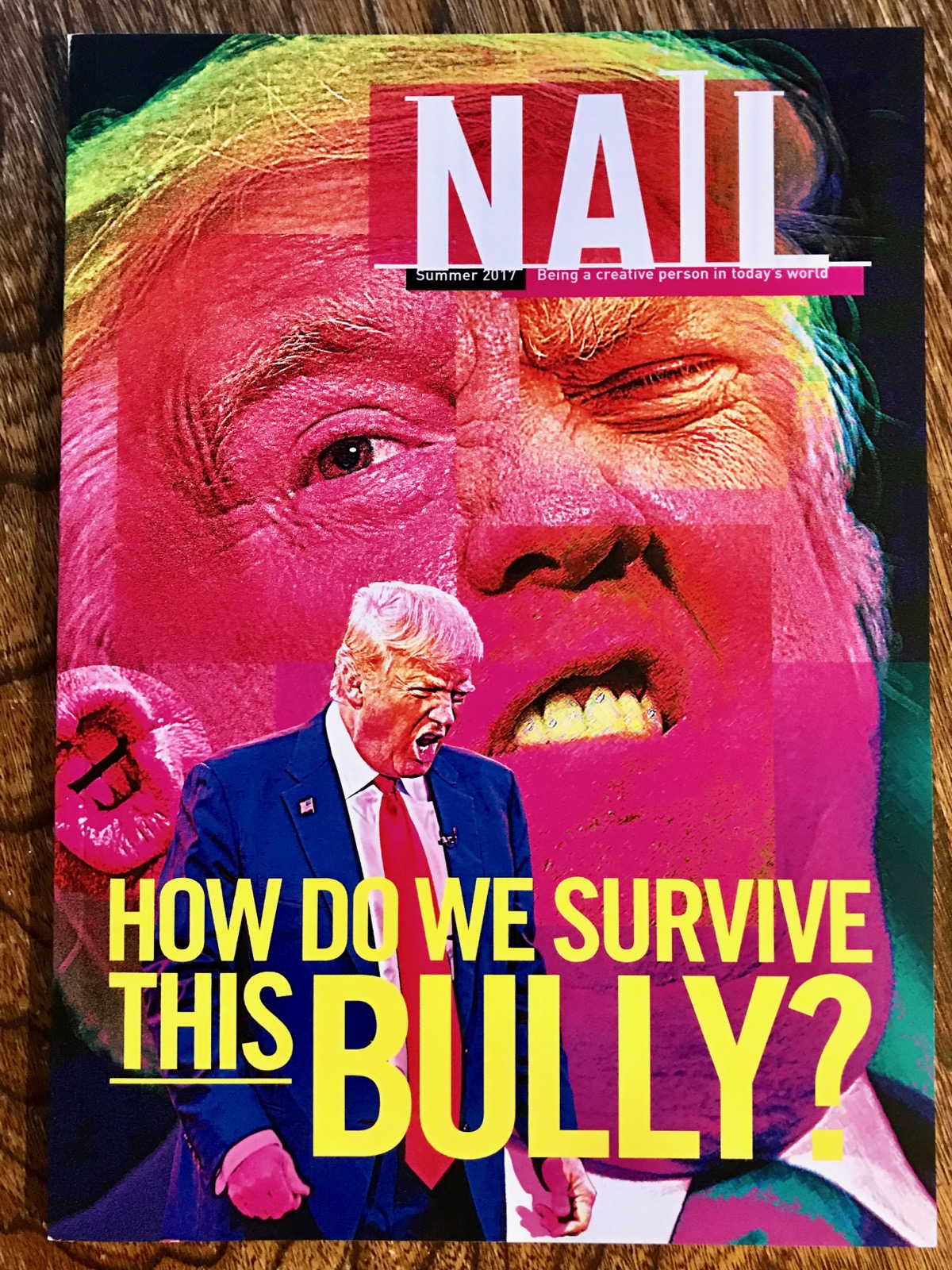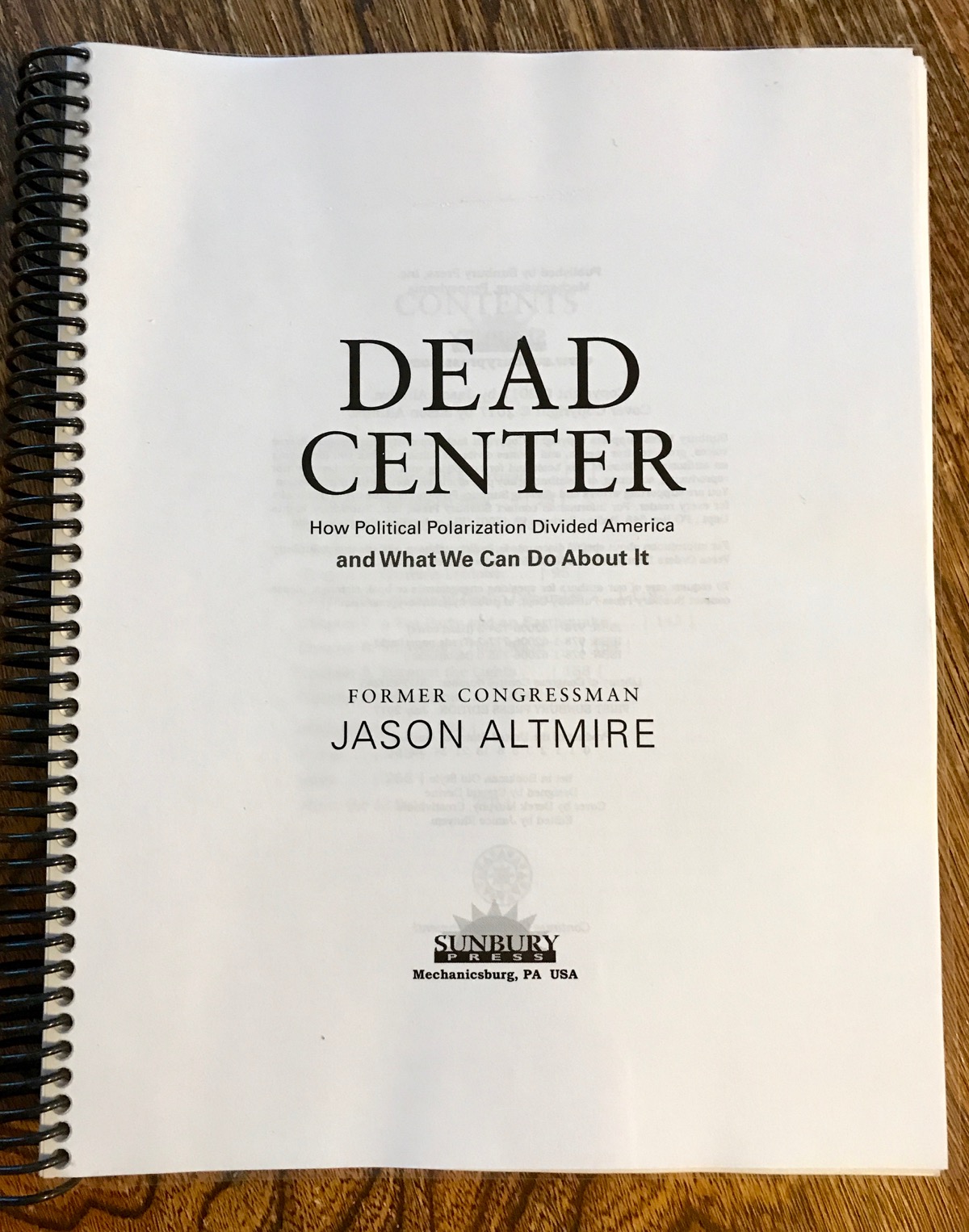Portrait Gallery: Barrett Martin
Each week, Christine Larsen creates a portrait of a new author for us. Have any favorites you’d love to see immortalized? Let us know
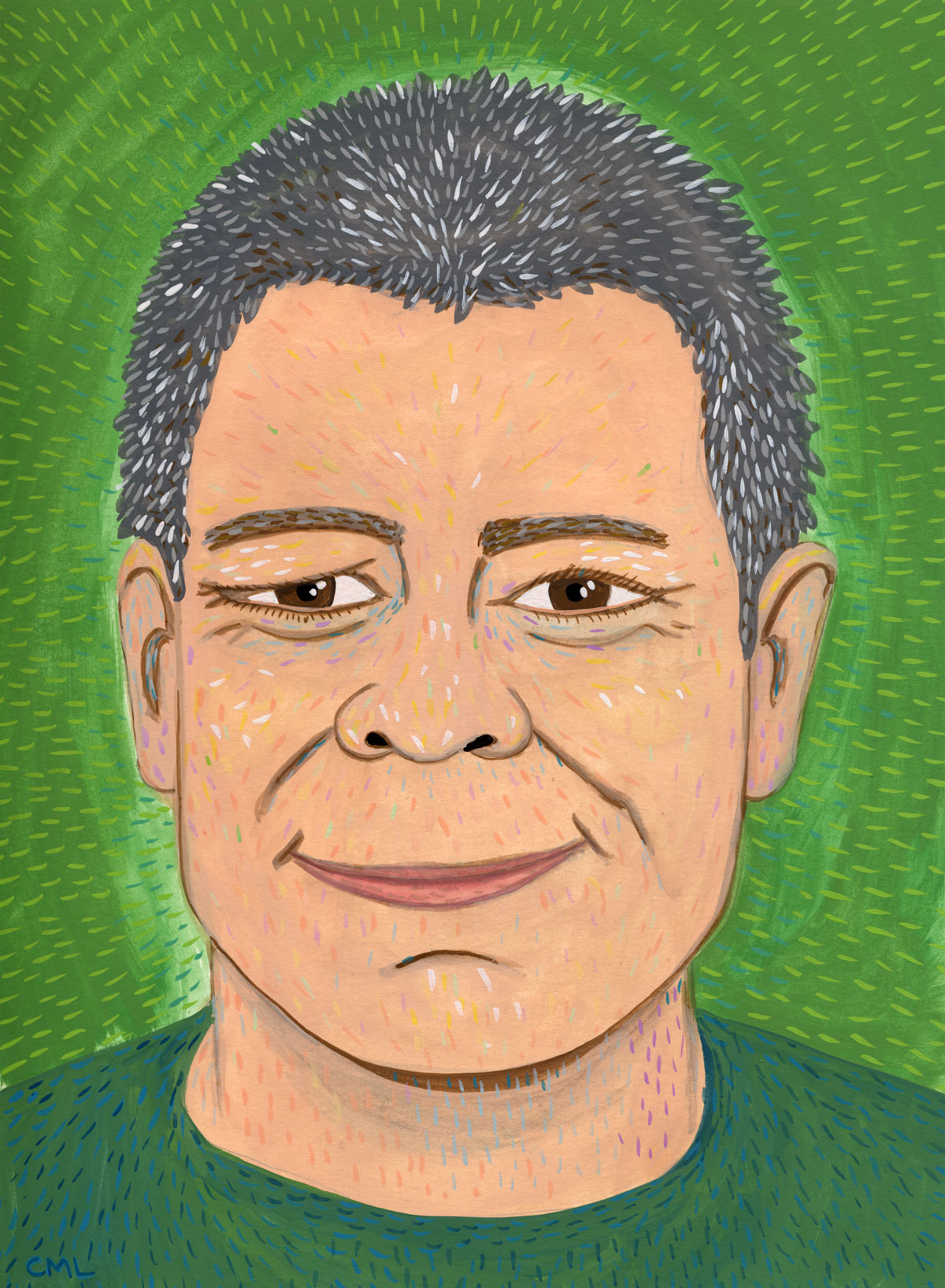
Thursday August 24th: The Singing Earth Reading
Seattle musician Barrett Martin (Skin Yard, Screaming Trees, Mad Season) is about to publish a new book titled The Singing Earth, which comes with an overstuffed CD. It’s about his time traveling the world and exploring “14 musical regions.” Today, he appears in conversation with Seattle treasure DJ Kevin Cole.KEXP Studios and Gathering Place, 421 1st Ave, 520-5800, http://kexp.org. Free. All ages. 6:30 p.m.
Criminal Fiction: (books about) criminals take no vacation
Every month, Daneet Steffens uncovers the latest goings on in mystery, suspense, and crime fiction. See previous columns on the Criminal Fiction archive page
In Melbourne, Australia, The Wheeler Centre has been celebrating all things bookish and literary since 2008, when Melbourne got its UNESCO City of Literature stamp of approval. Among their many events and discussions, the Centre has hosted a bevy of terrific crime-fiction writers and regularly shares videos and podcasts of those talks. Whether you’re a Reacher Creature, or a Kate Atkinson fan, there’s plenty of viewing/listening fun for you here. Other gems include conversations with Ian Rankin, Michael Connelly, Paula Hawkins and Peter James.
Reading around: new titles on the crime fiction scene
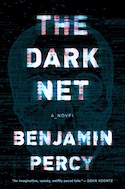
The zippy read that is The Dark Net by Benjamin Percy (Houghton Mifflin Harcourt), is not for the faint-of-heart. Hard-bitten Portland journalist — and Luddite, a personality quirk that comes in mighty handy in this particular context — Lela stumbles on the story of her life — so far — when she trips over an odd-looking skull in a construction site smack dab in the middle of the trendy Pearl District. And things go literally haywire from there. A rich mash-up of suspense, techno-thriller, horror, and the supernatural, Percy pulls it all together with a terrific cast of characters, finely-tuned plot twists and killer prose, sprinkled generously with spot-on snark and fun puns, as well as lovely turns of phrase: “…she hears the call to prayer as it purls and echoes through the city.”
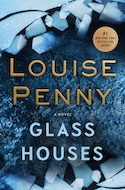
Louise Penny’s detective Armand Gamache of the deceptively cozy and quiet Three Pines Quebecois village, has been a steadfast presence on the mystery scene for more than a decade. Now that he’s tackled and rousted out corruption at the highest levels of the Sûréte du Quebec, what’s left for a Chief Superintendent to do? Plenty, as it turns out. Penny’s Glass Houses (Minotaur), a perfectly-structured novel, opens in a tension-filled Montreal courtroom. Then, the narrative shifts between Montreal and a chilly few days months earlier in Three Pines, when a mysterious figure stood on the village common and freaked everyone out. Penny’s produced a beautifully wrought and pleasurably clever novel about conscience, revenge, and one of the most potent criminal challenges of our time.
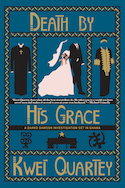
Murder hits uncomfortably close to home in Kwei Quartey’s Death by His Grace (Soho), when Chief Inspector Darko Dawson’s wife’s cousin is killed. The detective deals with heightened familial tensions — not to mention the deterioration of his aging father, the wayward ways of his adopted son, and a bout of malaria — all while working to ferret out a dangerous killer. There’s plenty of delicious Ghanaian food mentions to salivate over and a friendly overview of Accra’s plentiful neighborhoods, but Quartey covers the bad as well as the good: an inherent part of the plot here includes the workings — and cons — of a charismatic church and its self-enriching leader.
In Yesterday (Mulholland), Felicia Yap’s intricate and mind-bending debut, there’s murder with malice aforethought afoot and an ambitious, chess-obsessed detective on the case. But in Yap’s imagined world, unusual challenges abound: human memory is severely curtailed by either one or two days tops, and everyone tries to keep track of changes around them by updating (read: and possibly manipulating) their iDairy entries as best they can. A writer-turned-hopeful-politician and his long-suffering wife appear to be at the heart of the investigation; a vengeful woman appears to hold all the cards. In a novel with not one but four unreliable narrators at its core, you pretty much just have to strap in and go along for the bumplicious ride.
The Quintessential Interview: Ruth Ware

Ruth Ware’s third psychological thriller — and make no mistake, each of her novels melds psychological suspense with proper, page-turning thrills pretty damn flawlessly — is one of those books that breathes vibrant life into the term “atmospheric.” The Lying Game (Scout Press), features a remote and boggy estuary, a decrepit old mill-house, and a local village for local people: this is the setting for the reunion of four grown-up friends who, as girls, teased the people around them with often funny and sometimes cruel mind-games, and who may be about to get their comeuppance.
What or who are your top five writing inspirations?
I never know where inspiration will come from - for In a Dark, Dark Wood it was a chance conversation with a friend about hen nights. The Woman in Cabin 10 was me reading too many Agatha Christie novels, combined with some seriously scary news stories about deaths at sea (Is it me, or has there been a spate of them recently? Maybe it's a case of noticing what you're attuned to). The Lying Game was inspired by a place I visited in northern France (although being a writer, I swiftly snipped it out of its real-life setting and transposed it to the south of England). Online adverts. Books I've read. People I've met. Oh dear, this is more than five, isn't it?
Top five places to write?
I'm having the opposite problem here: I only write at my desk due to having screwed up my back by writing in bed and on the sofa. Bed is probably my very favorite place to write, but I can't really get away with it any more, even with the most artfully arranged pillows. If I can count plotting, then I love thinking while I'm driving or doing mindless, familiar walks — the sort you do every day and could complete almost with your eyes closed. When I lived in London, I did my best plotting on the Tube. I think the key is going into a sort of stasis trance — putting your brain on standby, almost.
Top five favorite authors?
Only five!! This is so hard. Um… Agatha Christie — for a masterclass in plot. Daphne du Maurier for that effortless combination of mystery and emotion. Donna Tartt for creating huge expansive worlds that I love to live in. Shirley Jackson for being simply creeptastic. Patricia Highsmith for creating fully three-dimensional characters who leap off the page and into your head. Wow, that was hard. It's also not complete. There are a whole load of writers I love just as much.
Top five tunes to write to?
Ok, I'm back to having too few answers for this one. I can't write to music; in fact, I really prefer complete silence.
Top five hometown spots?
I'm spending a lot of time on Brighton's Palace Pier, partly because it's a beautiful, crazy throwback to Victorian seaside life, partly as tangential research for my new book. My perfect Brighton day might involve a walk on the pier, throwing some stones into the sea, lunch at La Choza, a truly delicious Mexican restaurant in Brighton's North Lanes, then a drive out into the beautiful Sussex Downs for a drink in one of the country pubs. I love a pub with a proper beer garden – soft green grass underfoot and a wasp trapped under an up-turned beer glass. The Cricketers Arms in Berwick or the Ram Inn at Firle are both excellent. While I am out that way, I might drop into Charleston Farmhouse, once the Sussex refuge of the Bloomsbury circle and now a fascinating period piece, frozen in amber as tribute to them. If I had the energy, I'd finish up by climbing Firle Beacon, but more likely I'd just stretch out in the sunshine, watch the lengthening shadows, and order another glass of wine.
Thursday Comics Hangover: Dumbforgiven
My favorite writing podcast isn’t about poetry or novels or non-fiction. It’s about screenwriting. John August and Craig Mazin’s Scriptnotes is a long-running podcast that takes listener questions, offers industry interviews, and occasionally pulls screenplays apart to see how they work. While Mazin and August are sometimes a little too conventional in their advice — the film industry does love a formula — they’re great hosts who cheerfully provide useful information, and they’re terrific in the way they treat writing as a craft and not divine inspiration. Any writer could learn a lot from the way they discuss their jobs.
In their most recent episode — embedded above — August and Mazin discuss the script for the Clint Eastwood masterpiece Unforgiven. It’s one of their best episodes, because their obvious enthusiasm for the script shines through in every moment. They rightfully praise Unforgiven for its economy: every line in the script either advances the story or establishes theme and character, or (most likely) both. They discuss why the screenwriter, David Webb Peoples, made decisions that contradict every piece of advice you’ll read in screenwriting guides, and they debate decisions that Eastwood made as he translated the script to screen. I encourage any writer to listen to this podcast.
So. What does all this have to do with comics?
I’ve been thinking a lot about comics writer Mark Millar lately. Millar made news earlier this month when it was announced that he sold his creator-owned comics line, Millarworld, to Netflix in a development deal that has been rumored to be somewhere in the neighborhood of $50 million. Millar has been praised as “the Quentin Tarantino of comics,” likely because his books are generally full of “adult themes” like violence and swearing in a way that superficially resembles the aesthetic of Tarantino films.
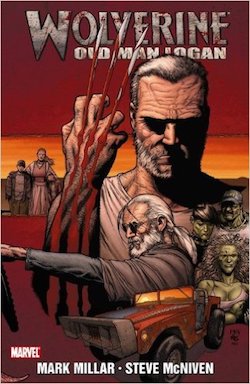
If you enjoyed the X-Men spinoff film Logan that was released in spring of this year, you probably know that it’s based on a Millar comic called Old Man Logan. Logan is far superior to Old Man Logan, in part because it’s handled with a maturity that continually escapes the comic. Millar’s Old Man Logan is a trashy joyride through a dystopian Marvel Comics future — one in which the Hulk fucks his own cousin, Spider-Man’s daughter is repeatedly ogled as jailbait, and the Red Skull dresses up in Captain America cosplay for cheap shocks.
At the time of its release, and repeatedly in years since, Old Man Logan has been sold to audiences as Unforgiven starring Wolverine. Superficially, that connection makes sense. Old Man Logan centers around an old man who was once a fearsome warrior but who hasn’t taken up arms in years. He’s reluctantly pushed back into his old life, and he’s eventually subsumed by the violence that swallowed his youth. In both stories, the hero is a threat, one that is teased from the very beginning of the story and only rolled out at the very end. It’s the same basic plot structure.
But listening to Mazin and August enthuse over what makes Unforgiven special really hammered home everything that’s terrible about Old Man Logan in specific, and Millar’s writing in general. Unforgiven is thematically about the stories we tell each other, and the distance between stories and reality. Old Man Logan is nothing more than a string of “cool” moments. It’s not about what it means to be a killer — Old Man Logan is a celebration of violence, written by someone who seems to think that Unforgiven exists so that Clint Eastwood can, in the end of the movie, shoot a bunch of people and look badass while he’s doing it.
And ultimately, that’s what all of Millar’s books are: bad misreadings of popular culture. His books build on premises that every 15-year-old comics nerd has idly wondered: What if Batman was actually the bad guy? What if Flash Gordon starred in Unforgiven? What if the bad guys killed all the superheroes? And then it does nothing more than revels in the “coolness” of the premise, providing a string of money shots that forcibly injects chills into the cerebral cortex of fanboys.
Of course, I suspect this off-brand hucksterism is not a bug for Netflix, but a feature. Comic book movies and shows based on Millar’s comics will appeal to the penny-pincher in all of us. They look enough like the real properties to be enticing to our basest instincts, and they’re stuffed full of enough violence and nasty thrills to keep us watching. And sometimes — as in Logan — talented filmmakers might be able to transform Millar's doggerel into verse.
As an investment, I'm sure Netflix feels pretty good about the content they bought. Unfortunately, Millar — who always reaches the most facile decisions — will only be emboldened by their purchase. He's just getting started.
Your Week in Readings: The best literary events from August 23rd - August 29th
Wednesday August 23rd: Seattle Urban Book Expo Panel Discussion
See our Literary Event of the Week for more details. Seattle Public Library, 1000 4th Ave., 386-4636, http://spl.org. Free. All ages. 7 p.m.Thursday August 24th: The Singing Earth Reading
Seattle musician Barrett Martin (Skin Yard, Screaming Trees, Mad Season) is about to publish a new book titled The Singing Earth, which comes with an overstuffed CD. It’s about his time traveling the world and exploring “14 musical regions.” Today, he appears in conversation with Seattle treasure DJ Kevin Cole. KEXP Studios and Gathering Place, 421 1st Ave, 520-5800, http://kexp.org. Free. All ages. 6:30 p.m.Friday August 25th: Gender Odyssey
Now that we’ve got an orange hate machine as president, it’s more important than ever for cisgender folks to ally themselves with the trans community. Maybe the best way to do that is by attending Gender Odyssey, a long-running (in its 16th year!) celebration of gender diversity. Authors and booksellers will be onhand to keep things nice and literary. Washington State Convention Center, 705 Pike St., 694-5000, http://www.genderodyssey.org/seattle/. $150. All ages. 9 a.m.Saturday, August 26th: Seattle Urban Book Expo
See our Literary Event of the Week for more details. Washington Hall, 153 14th Ave, http://washingtonhall.org. Pay what you can. All ages. 1 p.m.Sunday August 27th: Two Poets
Ana-Maurine Lara, Ph.D., is the author, most recently, of Kohnjehr Woman, a narrative poetry book about race and the South. She’s also working on setting her original poetry to music and visual art. Today, she appears with poet Claudia F. Savage, who you may know better as one-half of the poetry performance duo Thick in the Throat, Honey. Open Books, 2414 N. 45th St., 633-0811, http://openpoetrybooks.com. Free. All ages. 4:30 p.m.Monday August 28th: Thrilling Tales
A couple times a month, librarians at the downtown library spend their lunchtimes reading a short story aloud to adults. Today’s reading is “The Great Pretender,” by Stanley Ellin. It’s about an old woman who is trying to protect her comely granddaughter from lascivious men who want to do terrible things to her. Seattle Public Library, 1000 4th Ave., 386-4636, http://spl.org. Free. All ages. 12:05 p.m.
Tuesday August 29th: This Impossible Light Reading
Ravenna author Lily Myers celebrates the release of her newest book at her neighborhood bookstore. This Impossible Light is a young adult novel about a young woman struggling with an eating disorder. Perhaps the interesting thing about the book is that it’s written in verse, which is a trend in young adult books that I whole-heartedly endorse. Third Place Books Ravenna, 6504 20th Ave NE, 525-2347 http://thirdplacebooks.com. Free. All ages. 7 p.m.The Hugo House just made their slate of fall classes available to non-members. There's a lot of great stuff there, but here are a couple of classes to keep in mind from people who have published here at the Seattle Review of Books.
Anca Szilágyi is teaching two classes: a one-day class titled "Wall-to-Wall Writing Prompts," and a full 6-session fiction writing class called "Fiction I."
Similarly, poetry phenom Jamaica Baldwin is teaching "Poetry I," a six-class course offering the basics of poetry writing.
Go find the whole catalog on Hugo House's site.
Why can't literature deal with climate change?
Published August 23, 2017, at 11:00am
In The Great Derangement, Amitav Ghosh examines the outdated conventions of realistic fiction.
Literary Event of the Week: Seattle Urban Book Expo at Washington Hall
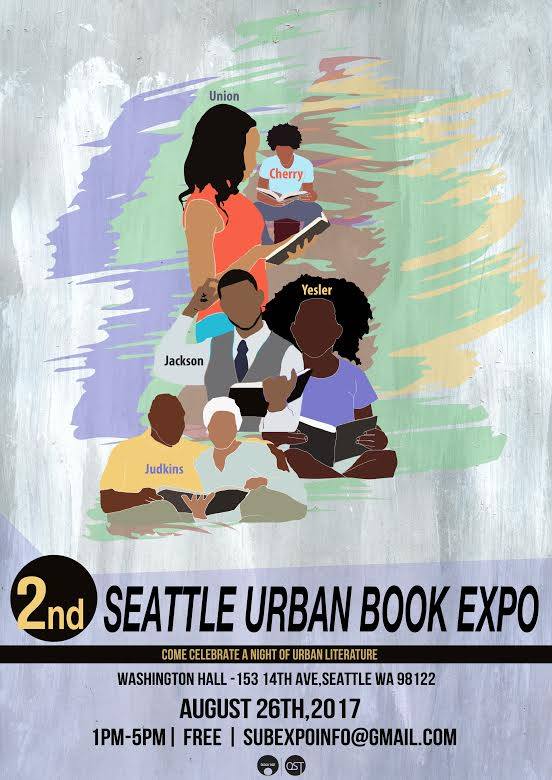
J.L. Cheatham II took his four-year-old daughter to the Tukwila Barnes & Noble to find her a book about her newest obsession — dinosaurs. Once they got to the kids’ section, he started looking around, and he noticed something: There were plenty of books about dinosaurs, but on “all the covers of the children’s books,” Cheatham tells me, “there were no black or brown faces.” He decided right then and there to write his daughter a dinosaur book that starred kids who look like her. After months of research, Cheatham published his first book: The Family Jones and the Eggs of Rex.
Cheatham learned then that publication isn’t the end of a process; it’s the very beginning. Authors today have to promote their own books and network around the clock. Cheatham was invited to participate in the Toronto Urban Book Expo, and “it blew my mind. Just the energy, the crowd, the music — everything.” When he returned home, Cheatham tried to get in contact with Seattle’s expo for authors of color. He quickly realized that this event simply doesn’t exist. Nobody in Seattle had put together an inclusive event for authors of color to find their fans, network, and celebrate their community.
So, naturally, Cheatham did it himself. Now, the Seattle Urban Book Expo is in its second year, and it’s grown at an exponential rate. The Expo happens on Saturday August 26th at Washington Hall from 1 to 5, and at 7 pm on Wednesday, August 23rd, Cheatham and other Expo authors will sit on a panel at the Seattle Public Library downtown to talk about their books and their experiences as authors. All are welcome.
What can people expect? Cheatham says “the goal is to have a literary party.” He’s signed up 20 authors for the Expo — more than twice last year’s roster — from a range of genres including comics, sci-fi, romance, erotica, and self-help. Part of Washington Hall will be turned over to kids’ entertainment (including face-painting and coloring writing classes) and the parking lot next to Washington Hall will be a full-service food court anchored by the Catfish Corner food truck. “I want people to show up and stay for a bit,” Cheatham explains.
As someone who has worked in and covered the book scene in Seattle for almost two decades, I’m embarrassed to admit to Cheatham that I don’t recognize many of the names of the participants at the Expo. Seattle is a segregated city in a lot of ways, and it seems that our literary scene is no exception. Cheatham is working hard to create an environment that puts these authors in front of the entire city. “We all want an opportunity. We just want a chance to show our work,” he says.
When that happens, things get better for everyone. As Cheatham puts it, “We just need to cultivate this bubbling artistic atmosphere that’s going on here in Seattle, you know?”
Awkward teenage poetry as a force for good
Published August 22, 2017, at 12:26pm
Seattle slam poet Lily Myers’s debut YA novel examines one young woman’s eating disorder through verse.
Do you own or have access to a 9,000 square-foot space in Seattle?
If so, you could offer to host the Friends of the Library's annual book sale.
The Friends of The Seattle Public Library is searching for a 9,000 square foot facility to process material for its annual book sales. The current lease at the Washington Talking Book & Braille Library in South Lake Union ends in late 2018. For the past 46 years, the Friends book sales have provided inexpensive used books to raise money for The Seattle Public Library.
Spread the word.
The Village Voice is ending its weekly print edition. End of a journalism era in New York City.
— Michael M. Grynbaum (@grynbaum) August 22, 2017
We are rapidly hurtling into a time in which young writers will reflect with awe on the fact that there were thousands of free alternative newsweeklies from coast to coast that employed writers — many on a full-time basis — to write about the life of the city.
And get a load of this bullshit:
Breaking: The Village Voice is ending its weekly print edition. pic.twitter.com/ATbXrP5qYh
— Ben Mullin (@BenMullin) August 22, 2017
On the Subject of Transformation
Last night I became a flock of birds on the eve of their descent.
Last night I was a murder of crows.
To be a murder of crows is to not know
if you are magic or dreaming,a flask of ring tones or a canvas of teachers
a worship of poets or a cashbox of planets.I did not know body or the hungering scratch for permission.
I was at once a marriage of galaxies, a shining glory of mistakes,a lumbering storm of shoelaces,
and a cinema of head turns.I walked like a torso of regrets heaving a crease of love letters,
written in blue, flowing downstream.I chose to live as a river of ripped journal pages,
a sprain of tears, spilling
into a spectacle of wringing hands.In the pitch, I became
a dictionary of guitars, strings taut and out of tune
I had forgotten what a migration of fingertips
feels like on the landscape of the skin,
I had forgotten I am not the strings
but the articulation of sound when they are played,
how forcefully we pour out of our bodies to be formless,how even in a foreign wrapping,
our bodies break
free of the stilled silence.
Love in the time of Brontosaurs
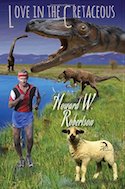
We're immensely grateful to this week's sponsor, Howard Robertson, for sharing an excerpt from his recent novel Love in the Cretaceous — which turns everything you learned from Jurassic Park on its head. In Robertson's Oregon, one hundred years from now, dinosaurs roam the earth, while humans are busy cutting off their own exit. Robertson, a notable local poet and fiction writer, throws his readers into the soup with love, loss, and extinction (and a very sinister cameo); the thrills in this one are metaphysical as well as primordial, as you'll see when you dip in.
Sponsors like Howard W. Robertson make the Seattle Review of Books possible. Did you know you could sponsor us, as well? Get your stories, or novel, or event in front of our passionate audience. Take a glance at our sponsorship information page for dates and details.
Amazon is still advertising on Breitbart
Now that former White House senior advisor Steve Bannon is back in charge of hyperconservative news outlet Breitbart, it's vitally important to note that Amazon is one of the last remaining mainstream advertisers on Breitbart.
.@amazon Please stop advertising on Breitbart
— Andy Richter (@AndyRichter) August 19, 2017
The organization Sleeping Giants has been on a crusade to convince Amazon to stop advertising on Breitbart. They responded to comedian Andy Richter's tweet above with an update on their crusade:
Thank, @AndyRichter! We've been informing advertisers when they show up on Breitbart for 10 months. 2500+ have left. @amazon doesn't care.
— Sleeping Giants (@slpng_giants) August 19, 2017
Think about that. More than 2,500 advertisers have realized that posting on Breitbart is bad for business. They've made the moral decision to stop advertising there. Amazon, after months of consumer advocacy from Sleeping Giants, still advertises on the site.
What will it take for Amazon to stop giving Steve Bannon money? What if you sent them an email? What if you canceled your Amazon account and told them that you decided that you could no longer be complicit in advancing a white supremacist agenda? Maybe your voice will be the one that tips Amazon over onto the right side of history.
It's vital to stop Steve Bannon from advancing his white supremacist agenda. Amazon is one of the last major mainstream funders of that agenda. They must stop advertising on Breitbart.
Why Jen Vaughn is joining forces with comics superstars like Neil Gaiman and Gerard Way to raise money for Planned Parenthood
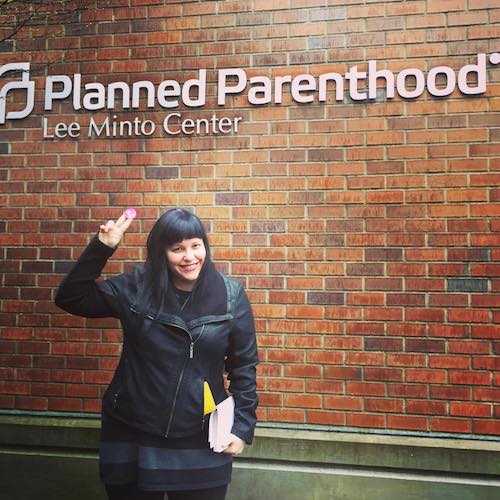
Last week, the founders of the website Comics Mix launched a Kickstarter for an anthology titled MINE!: A Comics Collection to Benefit Planned Parenthood. The anthology is star-studded, featuring writers like Neil Gaiman and Gerard Way and artists including Becky Cloonan and Jamaica Dyer. The project must reach $50,000 by September 15th to be published, though it’s already off to a great start. We talked with Seattle-area cartooning/inking/writing powerhouse Jen Vaughn about how she got involved with the project and why she’s such a passionate Planned Parenthood advocate.
Could you explain in your own words what Mine! is?
It’s a comics anthology featuring some of the best and brightest and then me. These stories turn their focus on a woman's right to her own body, the decisions she makes with it and the continuing struggle for women, especially women of color, to hold their agency. The title is derived from that ideology — it's MINE, so keep your fucking hands off it.
There are a lot of big names in this anthology. Are there any creators you're especially excited to share a pair of covers with?
Gabby Rivera, of Juliet Takes a Breath and America (the comic); Cecil Castelucci who writes Shade the Changing Girl — I just met her, she's fantastic. Tee Franklin is another writer who I'm excited about. She Kickstarted her new comic Bingo Love, and I'm ready to put my eyes on that book. Maia Kobabe and I traded comics at San Diego Comicon, they wrote and drew this moving comic on recognizing fascism through memory and books. I'm very ready to see their collaboration for Mine! And of course, Sarah Winifred Searle — I've always admired her work. We were both tabling at MeCAF (Maine Comic Arts Festival) in Portland, Maine back in, oh geez, 2011? It feels like we've been doing a lot of growing and drawing alongside each other, miles away and pages apart, so I'm pumped to be in another book with her.
You're a really busy freelancer. Why did you choose to get involved with this particular project? What does Planned Parenthood mean to you?
It's excellent that my facade of being busy is working! The timing was right when editor and organizer Joe Corallo contacted me, and I've had this story kicking around for awhile. Planned Parenthood has done a lot for me over the last 15 years.
I spent some formative high school and college years in Texas, and it's a very hostile place. There was a student group, VOX/Voices for Choice, I volunteered with at the University of Texas. We basically passed out free condoms, dental dams, taught people how to use them (to undo some of that religious health class BS about it being easier to not use condoms), and how to contact your Senators and Reps about Plan B.
Because we were in Austin, we occasionally went to committee meetings or public forums for healthcare. The reps on the healthcare boards would usually be five “old gray-faced white dudes with two dollar haircuts” and one young Catholic Latinx man. It was infuriating. It IS infuriating. I made a lot of bad college art about sexuality back then.
Also, because my mom's an intense baker, I had access to candy molds so I made LOTS of penis, vagina and birth control pill chocolates with all sales going to our college group and Planned Parenthood. If I didn't know people were racist by then, I certainly did when people only wanted to buy white guy penis chocolates — like anyone likes the taste of white chocolate.
I'm writing and drawing a bit of a fantasy piece so I'm not ruining any plot points by telling you Planned Parenthood was there for me during my abortion. I'd spent a year volunteering with Lillith Fund, a helpline which supported women emotionally and helped come up with ideas to crowdfund their clandestine abortions. It was wild, what could a 20 year old do to help a 35 year old desparate not to have yet another child, but their husband wouldn't use condoms or birth control.
Planned Parenthood has also been there for me every year when I go my engine checked out — so affordable compared to other places — and including this year when terrifyingly, I found a lump in my breast. (I'm fine, for now, though we're all moving closer to death).
Do you think artists have a responsibility to be political citizens? Do you think Trump changed that dynamic for you?
Artists cannot help but be political citizens, although it depends on the type of art, honestly. My idea behind every new project is to try something new — sometimes it’s art-related, sometimes it's writing-related. Part of my new goals, probably since moving to Seattle, have been to help lift up other people's voices, especially women of color — not that I'm monied or famous or in any position of power. This means drawing other people's stories or collaborating, not just owning the entire project, because it's a reflection of our society.
When I was growing up in the 80s and 90s, it seems like comics tried to be apolitical. On the one side, you had corporate comics, which didn't stand up for anything, really. And on the alternative side, you had cartoonists like Dan Clowes and Chris Ware who didn't seem to be particularly political. (Of course there were cartoonists like Roberta Gregory who were fearless in portraying abortion as a reality, but even her comics seemed to walk up to a line and then stop, politically speaking.) Is that changing? Are American comics developing a social consciousness? Or do you disagree with my reading?
Hmm. I think there's a difference between gag comics/political comics that emotionally resonate immediately versus a graphic novel that can manipulate character development and create compassion within the reader.
Being political now in comics isn't necessarily writing about politics, but being more inclusive with the dynamics of everyone creating them. It's like editor Joe Hughes bringing in writer Nnedi Okorafor to Vertigo a few years back; it's Gene Luen Yang building an empire with First Second from American Born Chinese to Secret Coders AND encouraging kids to a summer reading program with Reading Without Walls bookmarks (they were VERY realistic in suggesting 3 books since not all kids loved the library as much as say, I did). It's Hope Nicholson creating The Secret Loves of Geek Girls book and the soon-to-be-released follow up at Dark Horse, The Secret Loves of Geeks, that includes all genders and genderqueer people. It's the company Black Mask printing a series written by a trans writer, Magdalene Visaggio, with trans characters, drawn by Mexico-based Eva Cabrera (if you haven't read Kim + Kim by now, just GO — get yourself to the bookstore or library).
But with that being said, the 'slow death' of newspapers, and especially staff cartoonists, has left a gap in the world — one that is being met online by many cartoonists, especially Matt Bors at The Nib, with Nomi Kane, Pia Guerra, Joey Allson Sayers, Maia Kobabe and more. The political cartoons once clipped and taped above the breakroom coffee pot or to the door of the bathroom are now shared via social media. It's amazing how technology changes and we still see the same behaviors. (I just said that with my best Neil deGrasse Tyson voice)
What else are you working on? How can our readers keep up with you?
I'm finishing up some SECRET comics and covers that should be announced soon. But you can still pre-order my other current Kickstarter project, Haunted Tales of Gothic Love, edited by Hope Nicholson. Mel Gillman wrote a delicious queer love story featuring gold miners and a ghost; it's been quite fun to draw and I'm very sure it will haunt readers.
I'm working on multiple projects with writer, Kat Kruger, including just turning in that application for the Georgetown Steam Plant graphic novel project!
Locals can see me at the Red Pencil Conference on September 23rd. I'll be tabling with Kat Kruger and on an editing panel with Kristy Valenti of Fantagraphics and mainstream artist Moritat. And in March of 2018, I'll be tabling at Emerald City Comicon!
The Sunday Post for August 20, 2017
Annie Dillard's Classic Essay: 'Total Eclipse'
Instead of starting this week's picks looking backward at the barfing horror show of a week that proceeded it, let us turn our attention to the heavens, to the cleaving of our nation by a shadow stripe which will wend its way from west to east, a direction opposite the sun's travel (therefore significant, symbolically), and in that unearthly darkness (the shadow of which, for a minute or three, reminds us of one necessary constant in our lives that we barely pay enough heed to, the mostly unhidden sun) may the sins of our forbearers be purified in the birth of a new sun, a post eclipse sun, a sun whose rays pierce madness and bring succor to pain and horror and fear. Let this moment our country is experiencing be but a symptom of misunderstood celestial psychology; for ask any emergency room worker and they will tell you that things are worse at a full moon. Surely, then, there is a possibility that the madness we are amidst, this unhinged and unbalanced carnage of irrationality could be tied to the heavens and the gravitational bodies swinging against each other, drawn by the magnetism of our dense inflamed nuclear center. Let it be so. Let us be free of this terror.
Apparently, eclipses inspire great awe. Don't take my word for it, listen to Annie Dillard:
I had seen a partial eclipse in 1970. A partial eclipse is very interesting. It bears almost no relation to a total eclipse. Seeing a partial eclipse bears the same relation to seeing a total eclipse as kissing a man does to marrying him, or as flying in an airplane does to falling out of an airplane. Although the one experience precedes the other, it in no way prepares you for it. During a partial eclipse the sky does not darken—not even when 94 percent of the sun is hidden. Nor does the sun, seen colorless through protective devices, seem terribly strange. We have all seen a sliver of light in the sky; we have all seen the crescent moon by day. However, during a partial eclipse the air does indeed get cold, precisely as if someone were standing between you and the fire. And blackbirds do fly back to their roosts. I had seen a partial eclipse before, and here was another.
The White Lies of Craft Culture
Lauren Michele Jackson argues that the explosion of white-owned "craft" businesses are built on privilege and appropriation. You will not be surprised to learn this is not a new phenomenon. As Jackson points out, Jack Daniels himself learned how to distill from an enslaved black man named Nathan "Nearest" Green. Jackson visits barbecue and coffee as well, bringing forth the black history so readily ignored.
Craft culture looks like white people. The founders, so many former lawyers or bankers or advertising execs, tend to be white, the front-facing staff in their custom denim aprons tend to be white, the clientele sipping $10 beers tends to be white. Craft culture tells mostly white stories for mostly white consumers, and they nearly always sound the same: It begins somewhere remote-sounding like the mountains of Cottonwood, Idaho, or someplace quirky like a basement in Fort Collins, Colorado, or a loft in Brooklyn, where a (white) artisan, who has a vision of back in the day, when the food was real and the labor that produced it neither alienated nor obscured — and discovers a long-forgotten technique, plucked from an ur-knowledge as old as thought and a truth as pure as the soul.
Here’s What Really Happened In Charlottesville
Can you believe it hasn't even been a fucking week since that shitshow? A moment so present and intense in cultural life, that it will be the point they talk about in history books. You could feel how palpable it was, the needless and horrible deaths, the nazi inciting to violence, the militias armed to the teeth and ready to defend...something.
But of all the reports I've read from the ground, Blake Montgomery's coverage for BuzzFeed News is the clearest and most well laid-out. It's a nice companion piece to the Vice Media video that has been so widely shared.
Yes, you can blame the Nazis.
The race-fueled chaos that wracked Charlottesville, Virginia, finally came to rest on Sunday night. And the hundreds of people who spent the weekend fighting in streets — and the millions who watched them — began what has become a new American ritual: arguing about what really happened, and what a spasm of localized political violence means.
Was this an assault by racist extremists on innocent, rightly outraged Americans? Was it a clash between “many sides,” as President Trump notoriously said? Was the scale of the white supremacist threat blown out of proportion? Was the violence of the black-hooded “antifa” understated?
The answers are clearer on the ground than they are in the filter bubbles driven by fierce partisan argument on social media and cable news. They are complicated but not ambiguous. Here are a few:
An Open Letter To Our Fellow Jews
Michael Chabon and Ayelet Waldman draw the stark line in the sand for Jews who either support, or think they have found common cause with our president. There is no middle ground here, now that he has unequivocally showed his truth. The time to oppose him is now.
So, now you know. First he went after immigrants, the poor, Muslims, trans people and people of color, and you did nothing. You contributed to his campaign, you voted for him. You accepted positions on his staff and his councils. You entered into negotiations, cut deals, made contracts with him and his government.
Now he’s coming after you. The question is: what are you going to do about it? If you don’t feel, or can’t show, any concern, pain or understanding for the persecution and demonization of others, at least show a little self-interest. At least show a little sechel. At the very least, show a little self-respect.
Seattle Writing Prompts: the State Fair
Seattle Writing Prompts are intended to spark ideas for your writing, based on locations and stories of Seattle. Write something inspired by a prompt? Send it to us! We're looking to publish writing sparked by prompts.
Also, how are we doing? Are writing prompts useful to you? Could we be doing better? Reach out if you have ideas or feedback. We'd love to hear.

What's your favorite fair? Everybody thinks of the Washington State Fair ("the Puyallup"), around our parts, but that one is so big and crowded. Just north, in Monroe, is the smaller, but no less exciting, Evergreen State Fair, right at the Speedway, so you can watch drag races while eating your cotton candy. My personal favorite, since I spent a lot of time in Bellingham, is the Northwest Washington Fair, up in Lynden, Washington.
What makes the fair so great? It's surely not the junk food, the queasy-making rides, or the big concerts (in Lynden, you can see Night Ranger, in Monroe, Joan Jett — she puts on a mean show — but at the Puyallup, you can see Modest Mouse, the Beach Boys, Earth, Wind, and Fire, just to name a few of the major headliners). It's a kind of homespun insanity of 4H farm kids, mixed with cowboys and functional western fetish-wear, mashed into a rock 'n roll carny factory, that always has a tinge of a Stephen King story. Like, something could go terribly wrong at any minute.
It's the barnfuls of ribboned swine, next door to hucksters selling the latest gadget in a small booth, their microphones broadcasting their prattle to the walkers-by. It's the dress horses, and at least in Lynden, the Clydesdales, all hitched in a train to an open-back wagon that they high-walk around the ring. It's the John Deere tractors out for sale, and the little area where the RV dealer sets up so you can walk through your mobile dream.
Sure, it's the rides. It's getting whipped around on a ride where half the seats are closed, and the whole thing is shored up on the grass by some old boards. It's wondering what must have happened for that handwritten sign that says "no open toed shoes" to be made and stuck up. It's the weird math trying to figure out how many ride tickets you'll need to do everything you want. Then, it's those blissful few moments being tossed around and given a thrill, before coming back down to your own two feet and a desire to eat more.
Every bit of food is big at the fair, and not as expensive as you might find at a year-round amusement park. If it's not deep fried, it could be, and if it couldn't be, somebody has surely tried. Ice cream sandwiches the size your head, and so many hamburgers you have to wonder if they have a butcher tent out back of the beef barn to keep them supplied.
It's the change in the air as the sun goes down, and the little kids go home to bed. The teenagers rule the midway, as the parents go off to watch some country music. It's the pubescent explosion of promise, that oversized stuffed animal roped high above the games that could be won but for trying, and that first stolen kiss, sweet with sno cone syrup still on the lip.
The state fairs are many things to many people, and maybe that's why I love them so much. I never feel like I belong, in truth, but I always feel like I'm wandering through a thousand other stories, and getting to see so many parts of it. Makes it fun to think about what kind of things are happening there.
Today's prompts
They stuck her on the kiddie roller coaster again. Taking tickets. Getting the little shits in the cars, every other seat broken and unsafe. But as the kids went around the boring little track, she was watching across the way, at the Thrill-O-Wheel, where her connection was running the show. She was starting to get a bit antsy. The delivery was supposed to happen an hour ago, and the little shits might just drive her to madness before the fix came in. That's when the princess stepped up with her tickets and demanded entrance to the car in front, one of the broken ones.
It was a dare. When the person you have a crush on is going on a stomach-turning ride, and your friends volunteer you to go with, you can't say no. And maybe you can hold in the milkshake and fries you just ate and not throw up on your crush, and maybe they will reach out to grab your hand, like in your most feverish dream. But neither of you look at each other as the bars come down. Only after it's too late and they say "I really, really don't want to do this" and you say "oh god me neither" do you notice how both sets of your friends are laughing out loud. You both were set up.
They got a shipment of three thousand units before the fair. Balance boards, of all the goddamn things. "We'll do the health angle. Good for aging, agility, strength, that kind of bullshit. I'll get banners printed up tonight," Mark said. Desi thought it was better than last year, hawking those stupid juicers, but how good are they gonna do next to the fidget spinner booth? Maybe Desi was getting to old for the game. Maybe
Nobody pays attention to the meet-cute of best friends. Unless it's a romantic thing, nobody talks about anniversaries, or years together. Friendships outlast the marriages, sometimes, go through the illnesses and children and everything together. But nobody talks about how special they are, not really. But one started that day, all because of two coincidences. First, being next to each other on the giant slide, and chatting on the way up. Then, second, finding out they were working in the same ice cream booth. The story has yet to unfold, but one thing is worth saying up front: this friendship will span their whole lives, and they will never be closer to another than they are to each other.
"It's gonna be you," she said, leaning down and petting the side of her soon-to-be prize pig. "It's gonna be you. I know it. You're gonna take blue." The pig, dappled with black and pink, leaned into the hand and snorted, turning its head, its wet snout glistening in the morning light. "You're the prettiest pig, the smartest pig, the best all around pig, and I know you're gonna win." The pig looked up at her, seemed to cock an eyebrow, as if waiting for the but ... Then it came: "just so long, that is, as you don't let them know you can talk."
The date of this year's Lit Crawl was announced on Facebook this week. It will happen the evening of Thursday, October 19th and it will feature more than 35 events spread over more than 15 venues. If you already have plans for the evening of the 19th, you should cancel them. You can expect to be busy from 5 pm until bedtime.
The devil eats his own tail
Published August 18, 2017, at 10:26am
Today's news that Steve Bannon was fired from the White House is good news because it means a self-described villain no longer has direct access to the levers of power. But it's bad news because it means Bannon is free to do whatever he wants. What's his plan?



